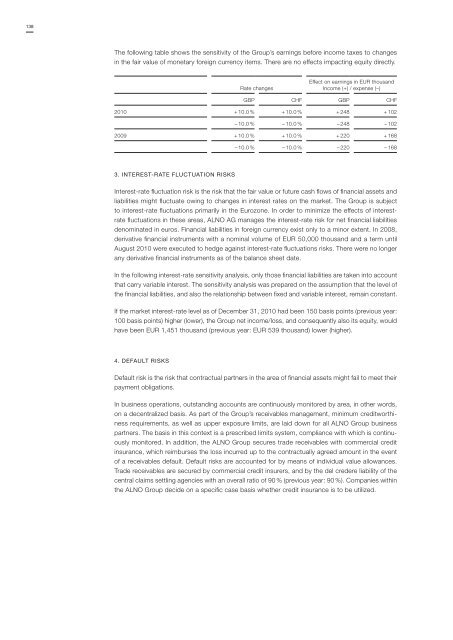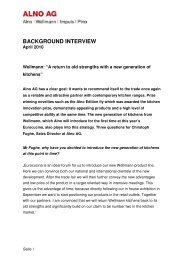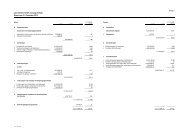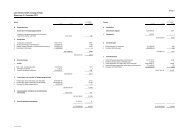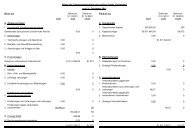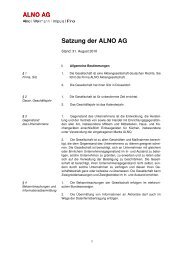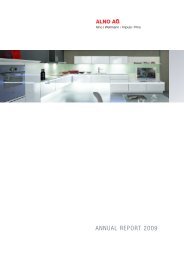100 % FUTURE - ALNO
100 % FUTURE - ALNO
100 % FUTURE - ALNO
Create successful ePaper yourself
Turn your PDF publications into a flip-book with our unique Google optimized e-Paper software.
138<br />
The following table shows the sensitivity of the Group’s earnings before income taxes to changes<br />
in the fair value of monetary foreign currency items. There are no effects impacting equity directly.<br />
Rate changes<br />
Effect on earnings in EUR thousand<br />
Income (+) / expense (–)<br />
GBP CHF GBP CHF<br />
2010 + 10.0 % + 10.0 % + 248 + 102<br />
– 10.0 % – 10.0 % – 248 – 102<br />
2009 + 10.0 % + 10.0 % + 220 + 168<br />
– 10.0 % – 10.0 % – 220 – 168<br />
3. INTEREST-RATE FLUCTUATION RISKS<br />
Interest-rate fluctuation risk is the risk that the fair value or future cash flows of financial assets and<br />
liabilities might fluctuate owing to changes in interest rates on the market. The Group is subject<br />
to interest-rate fluctuations primarily in the Eurozone. In order to minimize the effects of interestrate<br />
fluctuations in these areas, <strong>ALNO</strong> AG manages the interest-rate risk for net financial liabilities<br />
denominated in euros. Financial liabilities in foreign currency exist only to a minor extent. In 2008,<br />
derivative financial instruments with a nominal volume of EUR 50,000 thousand and a term until<br />
August 2010 were executed to hedge against interest-rate fluctuations risks. There were no longer<br />
any derivative financial instruments as of the balance sheet date.<br />
In the following interest-rate sensitivity analysis, only those financial liabilities are taken into account<br />
that carry variable interest. The sensitivity analysis was prepared on the assumption that the level of<br />
the financial liabilities, and also the relationship between fixed and variable interest, remain constant.<br />
If the market interest-rate level as of December 31, 2010 had been 150 basis points (previous year:<br />
<strong>100</strong> basis points) higher (lower), the Group net income/loss, and consequently also its equity, would<br />
have been EUR 1,451 thousand (previous year: EUR 539 thousand) lower (higher).<br />
4. DEFAULT RISKS<br />
Default risk is the risk that contractual partners in the area of financial assets might fail to meet their<br />
payment obligations.<br />
In business operations, outstanding accounts are continuously monitored by area, in other words,<br />
on a decentralized basis. As part of the Group’s receivables management, minimum creditworthiness<br />
requirements, as well as upper exposure limits, are laid down for all <strong>ALNO</strong> Group business<br />
partners. The basis in this context is a prescribed limits system, compliance with which is continuously<br />
monitored. In addition, the <strong>ALNO</strong> Group secures trade receivables with commercial credit<br />
insurance, which reimburses the loss incurred up to the contractually agreed amount in the event<br />
of a receivables default. Default risks are accounted for by means of individual value allowances.<br />
Trade receivables are secured by commercial credit insurers, and by the del credere liability of the<br />
central claims settling agencies with an overall ratio of 90 % (previous year: 90 %). Companies within<br />
the <strong>ALNO</strong> Group decide on a specific case basis whether credit insurance is to be utilized.


